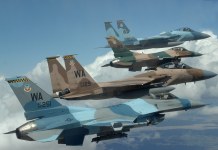Despite Russia having an array of excellent fighter jets at their disposal, the Sukhoi Su-35 clearly stands-out. The heavyweight Sukhoi jets represent the pinnacle of fourth-generation jet fighter design, capable of speeds of 2,800 kilometers per hour over an altitude of 11 kilometers, with a range of 4,500 kilometers.
Indian DRDO Developing ‘Anti-Terrorists Vehicle’ For Mission Kashmir
Perceived as the ultimate variant of the big Russian fighter sometimes referred to as the “Super Flanker” and distinguished by its unrivaled maneuverability, most of its electronics and weapons capabilities are a match to its western equivalents like F-15s, Eurofighters Typhoons, and Dassault Rafales.

The in-flight refueling capabilities of Su-35 makes them somewhat competitive with US F-35 fighter jets, and thereby make them an exciting proposition for several countries who might want to add such unsurpassed dogfighters to their existing fleet.
Which are the countries that have expressed interest, directly or indirectly to procure the Russian Super Flankers?
IRAN
After the United Nations Security Council (UNSC) rejected the United States draft resolution to extend the arms embargo indefinitely against Iran, Tehran will look to get its hands on the new shiny toys at its disposal.
According to press reports, Iran is looking to acquire a list of defense equipment from Moscow which includes the Su-35 or Su-57 fighters and S-400 air defense systems. According to experts, Iran’s primary focus will be on boosting its air defense capabilities and adding advanced fighter jets to its fleet to counter the Israeli threat.
EGYPT
Having procured 24 Rafale jets from France in 2015, Egypt inked a deal worth US$ 2 billion to acquire 24 Su-35 fighter jets from Moscow last year, as it looked to match its military might to that of Israel.
This comes amid the US’ objection to this deal where Secretary of State Mike Pompeo and Secretary of Defense Mark Esper urged Egypt’s defense minister to cancel the deal.
As per reports, the key objective of Egypt to acquire Su-35s over Rafale jets was that the Russian heavy-weight jets can outperform the Israeli and US warplanes in the Middle-East region.
“The sources indicated that these heavy and long-range fighter jets would give the Egyptian army superiority in the regional sky, which is why the US strongly objected.”
INDIA
Ever since India’s clash with China in eastern Ladakh, New Delhi has been working aggressively to procure military equipment to boost its defense.
Following the deal for the acquisition of 36 Rafale jets from France, and China and Pakistan lurking on both its shoulders, New Delhi would look to add more firepower to its military arsenal with the acquisition of heavyweight fighter jets like Su-35s.
In 2019, Moscow had offered to work with India as a Strategic Partner (SP) under the Make in India Initiative, when the MiG and Sukhoi series were competing for Indian Air Force’s (IAF) massive contract of 114 jets, with Russia choosing to collaborate with the state-owned Hindustan Aeronautics Ltd. as its SP.
With Su-35s considered as an interim solution, sources say that along with the manufacture of 114 Su-35s in India, the Russian offer includes the utilization of existing Su-35 technologies to modernize its existing fleet of over 250 Su-30MKI heavyweight fighters.
However, such plans could be thwarted by the United States, who have continued to issue warnings to India against the purchase of advanced anti-aircraft systems or fighter jets as such actions impede its defense cooperating with the west.
India is still exploring fighter jets and the SU-35s could be got contenders who could work in tandem with French Rafales.
TURKEY
Following Turkey’s acquisition of the long-range S-400 air defense missile systems, Turkey could yet again opt to add advanced fighter jets in the form of Su-35s to its aging fleet, which consists of fourth-generation US-built F-16 Fighting Falcons and older F-4 Phantom IIs.
Much like the case of Egypt, the US had repeatedly warned Turkey against going ahead with the S-400 deal. After Ankara ignored American request, the US eventually Kicked-out Turkey from the fifth-generation F-35 program, leaving Turkey to look for other options, the most attractive of which would be to go for Russian Su-35s.
ALGERIA
With Algeria and Morocco at loggerheads in the arms race, Algeria has reportedly signed contracts with Russia to acquire 42 Sukhoi fighter jets, which include the acquisition of 14 Su-34 bombers, 14 Su-35 fighters, and 14 Su-57 Stealth Fighters.
Their military plans to deploy two squadrons of Su-30MKA jets and one squadron each of Su-57s, Su-35s, and Mig-29M2s, with plans for two squadrons of modernized Su-24s and one Su-34 squadron for the bomber fleet also in place. Despite Russian officials not confirming these reports, the contract should be concluded by 2025.
VIETNAM
Vietnam, which has been one of the world’s most active arms importers in recent times, had in 2019 signed a $350 million deal with Russia to buy 12 Yak-130 combat training jets, which will be added to their fleet, which already deploys Russian made fighter jets, surface ships and submarines, cementing Russia’s place as the biggest arms supplier to Vietnam. The deal paves the way for the country to acquire advanced jets like Su-35s.
INDONESIA
According to reports, Indonesia had planned on purchasing 11 Su-35s from Russia in a deal worth $1.1 billion. Following Indonesia’s decision, the US stepped in and applied pressure on Indonesia to cancel the deal for the heavyweight fighters, with reports of the deal falling through soon after.
But according to Dmitry Shugayev, Director of Russia’s Federal Service for Military-Technical Cooperation (FSVTS), the deal is still in place.
“There is no official cancellation of the (Indonesian) order (for the Su-35s),” We haven’t received any papers regarding the issue and haven’t been told about it. We hope that the contract will be implemented.” No further details were provided.” Said Shugayev




